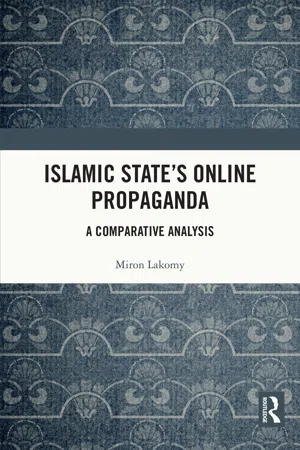
- 272 pages
- English
- ePUB (mobile friendly)
- Available on iOS & Android
About this book
Explaining the means utilised by the editors of the Islamic State's online magazines to win the "hearts and minds" of their audiences, this book is a result of a multidimensional content analysis of two flagship periodicals of the Islamic State: Dabiq and Rumiyah.
Drawing from a number of theoretical concepts in propaganda studies, the research uses comparative analysis to understand the evolution of the modus operandi employed by the editorial staff. The volume evaluates the types of arguments used in these magazines, as well as the emotions and behaviour that these triggered in readers. This book concentrates on the formats and thematic composition of a variety of the Islamic State's e-periodicals, including Dabiq, Rumiyah, Dar al-Islam or Konstantiniyye, from the viewpoint of the constantly changing strategic situation and priorities of the "Caliphate." The e-magazines of the post-territorial phase of the Islamic State, e.g. From Dabiq to Rome and Youth of the Caliphate, were also taken into consideration.
Overall, this book does not only offer new insights into the propaganda methods of the Islamic State's periodicals, but it also summarises their rise and fall between 2014 and 2019. The volume is dedicated mostly to academics and postgraduate students specialised in terrorism studies, political violence, and security studies.
Frequently asked questions
- Essential is ideal for learners and professionals who enjoy exploring a wide range of subjects. Access the Essential Library with 800,000+ trusted titles and best-sellers across business, personal growth, and the humanities. Includes unlimited reading time and Standard Read Aloud voice.
- Complete: Perfect for advanced learners and researchers needing full, unrestricted access. Unlock 1.4M+ books across hundreds of subjects, including academic and specialized titles. The Complete Plan also includes advanced features like Premium Read Aloud and Research Assistant.
Please note we cannot support devices running on iOS 13 and Android 7 or earlier. Learn more about using the app.
Information
1 Going virtual
Islamic State’s shock and awe campaign on the Internet
1.1Origins of the “virtual Caliphate”
the nature of this relationship between individuals and the Internet favors the Salafi message. The Internet both appeals to and fosters disembeddedness […] it appeals to isolated individuals by easing their loneliness through connections to people sharing some commonality […] it leads them to spend more time with this virtual community at the expense of interaction with the immediate social environment.3
share their hopes and dreams with their virtual friends […] Some might have joined a given forum out of a sense of alienation, of feeling alone […] This mutual sharing makes them feel ever closer to each other, in a virtual process similar to the one previously described as in-group love with face-to-face interactions. This provides them with a sense of belonging to a greater community on the basis of what they have in common, Islam.12
Table of contents
- Cover
- Half Title
- Title Page
- Copyright Page
- Dedication
- Table of Contents
- Acknowledgements
- List of Figures
- List of Tables
- Introduction
- Chapter 1: Going virtual
- Chapter 2: United they stand
- Chapter 3: Reading between the lines
- Conclusions
- Bibliography
- Index